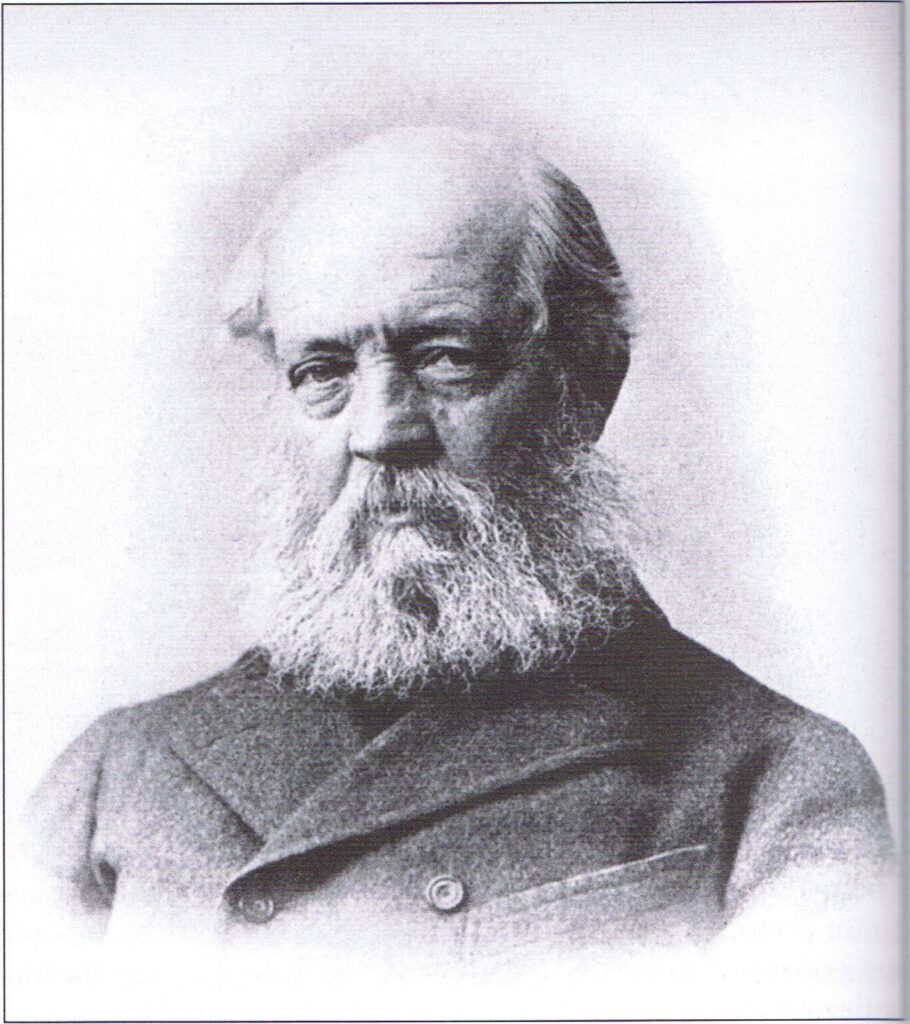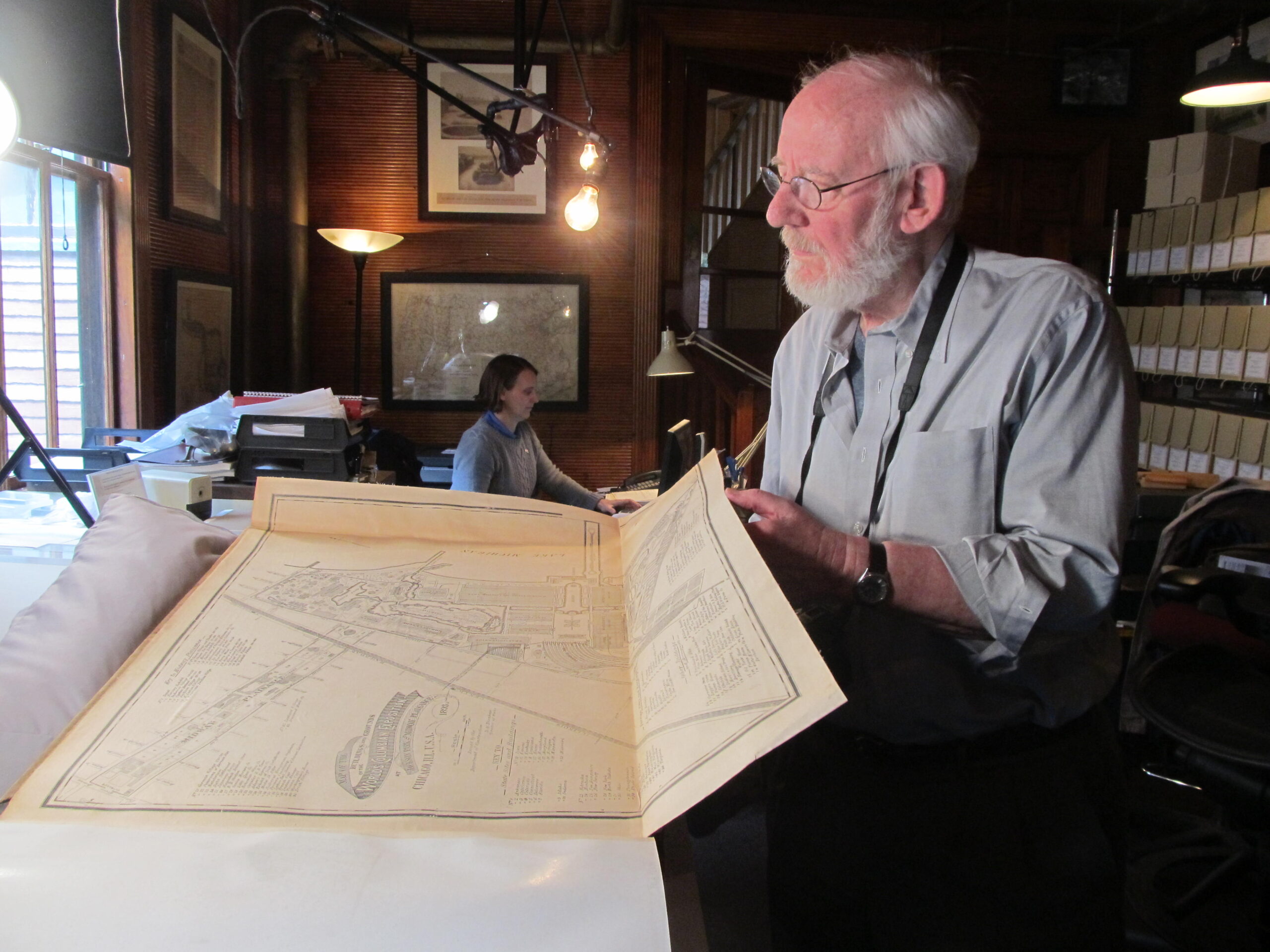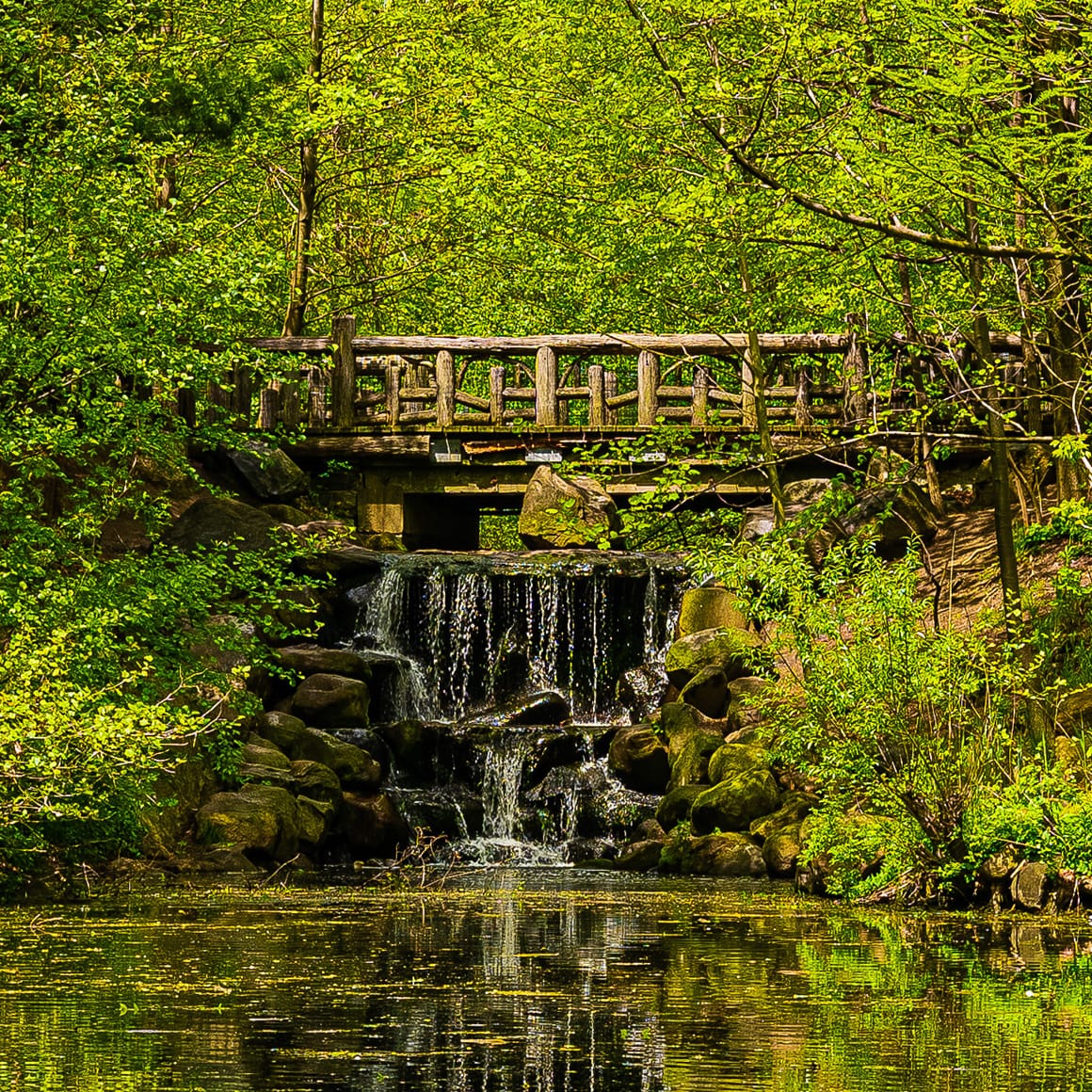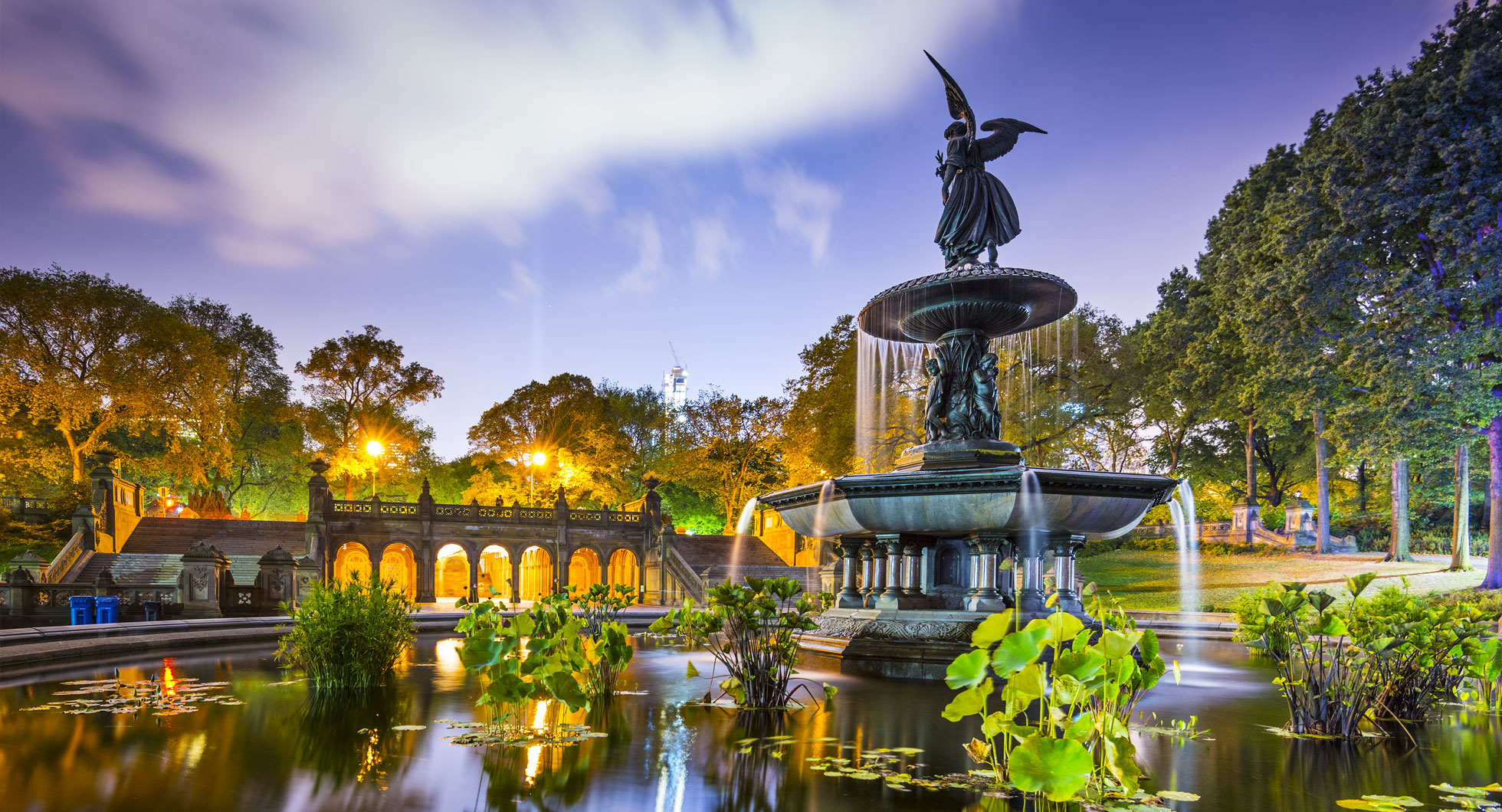
Frederick Law Olmsted came to the profession of landscape architecture late in his career. For 30 years after 1837 he served as an administrator-first of New York’s Central Park, then of the U.S. Sanitary Commission, and finally of the Mariposa Mining Company in California. Although he was co-designer of Central Park in 1858, it was not until 1865 when he was 43, that he made the final decision to devote himself to landscape architecture.
Despite his late commitment to landscape design, Olmsted’s ideas on the subject had taken form long before he thought of himself as a landscape designer or attempted anything of the sort in a professional way. His ideas had their basis in the experiences and influences of his youth.
The strongest influence came from his father, who greatly enjoyed natural scenery and devoted most of his leisure time to seeking it out. As soon as young Frederick was old enough, his father set him on a pillow in front of his saddle and took his son through the countryside around their home in Hartford, CT. These short rides expanded to become annual “tours in search of the picturesque” that took Olmsted, by the age of 16, through the Connecticut Valley and White Mountains, up the Hudson River and westward to the Adirondacks, Lake George and Niagara Falls. As he acknowledged late in his career, “The root of all my good work is an early respect for, regard and enjoyment of scenery… and extraordinary opportunities for cultivating susceptibility to the power of scenery.”1
The American landscape itself was the source of Olmsted’s earliest lessons in aesthetics but that influence was soon supplemented by the writings of late 18th-century English landscape gardeners, travelers and theorists of landscape art. In his youth he read and was influenced thereafter by An Essay on the Picturesque, by Uvedale Price, published in 1794, and Remarks on Forest Scenery and Other Woodland Views (Related Chiefly to Picturesque Beauty), Illustrated in the Scenes of the New Forest, by William Gilpin, published in 1790. Late in his career, Olmsted described these as “Books of the last century, but which I esteem so much more than any published since, as stimulating the exercise of judgment in matters of my art, that I put them into the hands of my pupils as soon as they come into our office, saying, ‘You are to read these seriously, as a student of Law would read Blackstone.'”2 The professional gardener who most influenced Olmsted was Humphry Repton, whose Sketches and Hints on Landscape Gardening and The Theory and Practice of Landscape Gardening were published in 1795 and 1803, respectively.
Bases of Olmsted’s Aesthetic Theories
The teachings of Price, Gilpin and Repton and the quiet example of his father provided the basis for Olmsted’s aesthetic theories; they also underlay his refusal to follow the gardening fashions of his own time. The horticultural revolution of the early 19th century led gardeners to neglect older theories of design and concentrate on displaying the many new species of plants and flowers available to them. The gardening practices fostered by the rapid increase in plant materials led to what Olmsted called “a display of novelty, of fashion, of scientific or virtuoso inclinations and of decoration.”3 Even in England he found that specimen planting and flower-bedding of exotics was intruding on the older designs of landscape gardeners.
Olmsted’s dislike of current fashions made him reluctant to accept the term “landscape gardening” for his own art. His feeling that he worked on a larger scale than did gardeners helped to strengthen that reluctance. The term “gardening,” he observed, “does not conveniently include…exposing great ledges, damming streams, making lakes, tunnels, bridges, terraces and canals.” Therefore, he asserted, “Nothing can be written on the subject with profit…in which extreme care is not taken to discriminate between what is meant in common use of the words garden, gardening, gardener and the art which I try to pursue.”4
Olmsted differed from gardeners not only in the style and scale of his work, but also in his concept of the process by which he intended his designs to affect those who viewed them. As a result of his own experience and wide reading, he concluded that the most powerful effect of scenery was one that worked by an unconscious process.
Influence of von Zimmermann and Bushnell
The two writers who most influenced his thought on this subject were the 18th century Swiss physician, Johann Georg von Zimmermann, and the prominent Congregational theologian of Olmsted’s own time, Horace Bushnell. In his book Ueber Die Einsamkeit, or Solitude Considered, with Respect to Its Influence on the Mind and the Heart, Zimmermann told how he had reluctantly left his mountain canton of Berne to minister to the ailing Frederick the Great. Separated from his home and family, he sank into deep melancholy that was assuaged only be daily walks in a garden “cultivated in the English taste” of a friend near Hanover. His curiosity aroused, Zimmermann began a search for the explanation of nature’s ability to heal derangements of the mind. He concluded that scenery worked its powerful effect through the imagination.”5 Olmsted read Zimmermann’s book as a boy, rediscovered it at the age of 22, and treasured it thereafter. To the Swiss physician’s theories he added the teachings concerning the importance of “unconscious influence” of Horace Bushnell, who was for many years his family’s minister in Hartford.
The most important and constant influence that people exerted on each other, Bushnell believed, was not verbal, but rather a silent emanation of their real character that showed in their habitual conduct and made itself felt at a level below that of consciousness. Olmsted realized that he had learned much about scenery from his father’s silent appreciation of it, and soon combined his own experience with the theories of Zimmermann and Bushnell to produce his own theory of the effect of scenery on man.
Scenery, he decided, worked by an unconscious process to produce relaxing and “unbending” of faculties made tense by the strain noise and artificial surroundings of urban life. The necessary condition for such an experience was the absence of distractions and demands on the conscious mind. The effect came not as a result of examination, analysis or comparison, nor of appreciation of particular parts of the scene; rather, it came in such a way that the viewer was unaware of its workings.
By the time Olmsted first wrote about the effect of scenery, his ideas were already well established. Describing his response to the beauty of parts of the Isle of Wight during his first trip to England in 1850, he said, “Gradually and silently the charm comes over us; we know not exactly where or how.” One could not seek that feeling too directly, however. “Dame Nature is a gentlewoman,” he cautioned, “No guide’s fee will obtain you her favor, no abrupt demand; hardly will she bear questioning, or direct, curious gazing at her beauty”6
“Service Must Precede Art”
When in later years Olmsted described the process by which he wished his own landscape designs to have their effect, his basis was the same theory of unconscious influence. In one classic example, he contrasted the effect of a common wildflower on a grassy bank with that of a gaudy hybrid of the same genus, imported from Japan and blooming under glass in an enameled vase. The hybrid would draw immediate attention. He observed, but “the former, while we have passed it by without stopping, and while it has not interrupted our conversation or called for remark, may possibly, with other objects of the same class, have touched us more, may have come home to us more, may have had a more soothing and refreshing sanitary influence.”7
Olmsted’s emphasis on the “sanitary” influence of his style of landscape design reflected his desire to have his designs produce an effect on the whole human organism. He believed that such service to human needs, and not simply the creation of decoration, should underlie all art. “Service must precede art,” he declared, “since all turf, trees, flowers, fences, walks, water, paint, plaster, posts and pillars in or under which there is not a purpose of direct utility or service are inartistic if not barbarous. … So long as considerations of utility are neglected or overridden by considerations of ornament, there will be not true art.”8
Design Principles
The desire to use landscape art to meet deep human needs, coupled with his conviction that the process involved must be an unconscious one, led Olmsted to insist on a whole series of design principles that differed significantly from those of the gardeners of his day. In the broadest sense, he felt that what separated his art from that of the gardener was what he termed the “elegance of design” – the creation of a composition in which all parts were subordinated to a single, coherent effect. There was not place in his work for details that were to be viewed and admired as such. People should not, he warned think “of trees as trees, of turf, water, rocks, bridges, as things of beauty in themselves.” In his art they were “as little so as warp & woof in a brocade.”9
A crucial element in securing composition was the effective organization of space. No matter how limited the area he had to design, Olmsted sought to create a “perspective effect,” increasing the sense of space contrasting dark foreground forms with lighter, less distinct ones further away. He termed scenery “simply did not apply, he said, “to any field of vision in which all that is to be seen is clear and well-defined in outline.” Accordingly, he introduced into the scenes he designed either “considerable complexity of light and shadow near the eye,” or “obscurity of detail further away.”10
Each of these techniques was characteristic of one of the two styles Olmsted most of 10 used in his designs. Basically, they were the Beautiful and the Picturesque — the classic modes of English landscape gardeners and theorists of the late 18th century. Olmsted’s purpose was not simply to use these styles for aesthetic effect and consistency. He used them to heighten certain qualities of nature in order to produce a psychological response that went beyond appreciation of the beauty of the scene.
The “Pastoral” Style
Olmsted used the style of the Beautiful — or as he usually called it, the pastoral — to create a sense of the peacefulness of nature and to sooth and restore the spirit. The Pastoral style was the basic mode of his park designs, which he intended to serve as the setting for “unconscious or indirect recreation.”
The chief purpose of a park, he taught, was “an effect on the human organism by an action of what it presents to view, which action, like that of music, is of a kind that goes back of thought, and cannot be fully given the form of words.”11 In such designs there were broad spaces of greensward, broken occasionally by groves of trees. The boundary was indistinct, due to the “obscurity of detail further away” produced by the uneven line and intricate foliage of the trees on the edge of the open space. In other parts the reflection of foliage by bodies of water introduced another element of intricacy and indistinctness. The effect was reminiscent of parks on estates that Olmsted had seen in England, and it was the image of the rich turf of that country, which he described as “green, dripping, glistening, gorgeous,” when he first saw it, that remained for him the model of the Pastoral style.
The “Picturesque” Style
When employed the style of the Picturesque, Olmsted introduced “complexity of light and shadow near the eye” to heighten another aspect of nature — its mystery and bounteousness. To achieve a sense of mystery, he used a variety of tints and textures of foliage that made forms indistinct and created a constantly changing play of light and shadow. At the same time, he planted profusely to secure greater richness and lushness of growth than nature would produce unaided. He planted one layer upon another, beginning with ground cover, then shrubs, then trees above them. To complete the effect, he often added creepers that covered the trunks and branches of deciduous trees, keeping them green with foliage even in winter.
Part of Olmsted’s inspiration for this style was the thick hedgerows of England, but even more important was the tropical scenery he had seen in Central America. Crossing the Isthmus of Panama in 1863, he had been enthralled: “…simply in vegetation it is superb and glorious,” he exclaimed to his wife, “and makes all our model scenery very tame and Quakerish. I think it produces a very strong moral impression through an enlarged sense of the bounteousness of nature.”12 It was that quality of nature, and of the Creator behind it, that he sought to express and present in many of his designs thereafter.
The Genius of the Place
By heightening certain qualities of nature, Olmsted adhered to his view that the purpose of the landscape architect was to give people “greater enjoyment of scenery than they could otherwise have consistently with convenience within a given space.”13 At the same time, he wanted his designs to remain true to the character of their natural surroundings, and not to clash with them. The failure of flower bedding and specimen-planting of hybrids to follow the basic rule was one of his chief reasons for seeking to differentiate his art from that of gardening. In his respect, as in many others, he kept alive the teachings of eighteenth-century English writers on landscape art. Alexander Pope had recommended the same approach in his advice to the Earl of Burlington to “Consult the genius of the place in all,”14 and Humphry Repton began his first work on landscape gardening with the statement, “All rational improvement of grounds is, necessarily founded on a due attention to the character and situation of the place to be improved.”15
Olmsted consistently sought to follow these precepts and believed that he succeeded. Thirty years after he helped to design Central Park, he observed to his ex-partner, Calvert Vaux, “The great merit of all the works you and I have done is that in them the larger opportunities of the topography have not been wasted in aiming at ordinary suburban gardening, cottage gardening effects. We have let it alone more than most gardeners can. But never too much, hardly enough.”16 At that point, Olmsted was beginning the series of designs including Franklin Park in Boston, the Biltmore Estate in North Carolina, and the World’s Columbian Exposition in Chicago, that would clearly set him further on that path than any of his contemporaries, including Vaux.
While Olmsted sought to make each design unique by basing it on the special qualities of the individual site, he was not willing to use only native plants in his creation of scenery. He used many plants that were already part of the landscape character of the place and he knew they would thrive with little care. Still, he was anxious to enrich the natural scenery, and to do so he was willing to employ any thrifty plant that would add richness and variety without striking the average viewer as unnatural or exotic.
Through all the designs that Olmsted created there runs one dominating and consistent conception. He always insisted on the subordination of details to an overall composition whose strongest and fullest effect was to act unconsciously on those who viewed it. He vigilantly guarded against distracting elements that would intrude on the consciousness of the observer. In the process, he simplified the scene, clearing and planting to clarify the “leading motive” of the natural site and heighten the effect of a particular quality of nature. He often challenged the fashions and preconceptions of his day and encountered the opposition of those who found his style too rough and unkempt. He persisted, however, and adapted the old principles of English landscape gardening to American conditions, while at the same time developing his own theory of the unconscious influence of scenery. The result was a series of designs that combined richness and wildness of planting with unified composition in a way never equaled in the history of landscape design.
*This article is reprinted from the Twenty-fifth Anniversary issue of Nineteenth Century, the journal of the Victorian Society in America (Volume 20, no. 2, pp. 32–37, Fall 2000)
Notes:
- FLO to Mariana Griswold Van Rensselaer (draft, [June 1893]), Frederick Law Olmsted Papers, Library of Congress.
- RETURN 2. FLO to Elizabeth Baldwin Whitney, Dec. 16, 1890, Olmsted Papers, LC.RETURN
- Manuscript fragment, Olmsted Papers, LC RETURN
- FLO to Mariana Griswold Van Rensselaer, May 22, 1893, Olmsted Papers, LC. RETURN
- Johann Georg Ritter von Zimmermann, Solitude Considered, with Respect to Its Influence Upon the Mind and the Heart…. J.B. Mercier, ‘trans. (New London, Conn., 1807), p. 174. RETURN
- [Frederick Law Olmsted], Walks and Talks of an American Farmer in England (New York, 1852), 11:155. RETURN
- Frederick Law Olmsted, “Trees in Streets and in Parks,” The Sanitarian X, No.114 (September, 1882): 518. RETURN
- Manuscript fragment. Olmsted Papers, LC. RETURN
- Manuscript fragment. Olmsted Papers, LC. RETURN
- Draft of “Address to Civil Engineers,” Olmsted Papers, LC. RETURN
- Boston, Department of Parks, [Frederick Law Olmsted], “Notes on the Plan of Franklin Park and Related Matters” (Boston, 1886) p. 107. RETURN
- FLO to Mary Perkins Olmsted, Sept. 25,1863, Olmsted Papers, LC. RETURN
- Manuscript fragment, Olmsted Papers, LC. RETURN
- Alexander Pope, “Epistle to the Earl of Burlington.” RETURN
- Humphry Repton, “Sketches and Hints on Landscape Gardening,” in The Art of Landscape Gardening by Humphry Repton, Esq., Including his “Sketches and Hints on Landscape Gardening,” ed. John Nolen (Boston and New York, 1907), p. 7. RETURN
- FLO to Calvert Vaux, September 3, 1887, Vaux Papers, New York Public Library. RETURN











